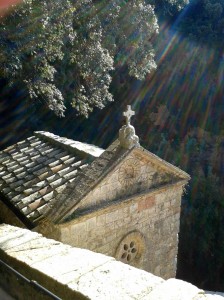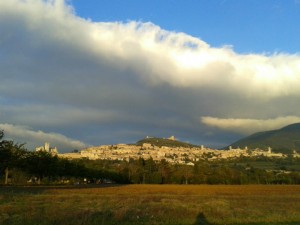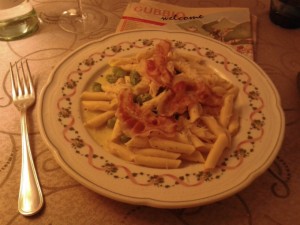Sunday 26th October 2014
The trip gets off to a really bad start, courtesy (or lack thereof) of 35 year old man at the Goldcar rental counter. There was no transfer shuttle at the terminal so a few of us walked round, not far, to the car rental building. I passed the Firefly counter and thought, phew, thank God I am not using them – they gave and continue to give much grief to Sara over a minor scrape (responsibility totally accepted by Dutch family who hit her when she was stationary) in the hills above Rayol in August.
No queue at Goldcar. Having already paid for the car hire in the UK via auto-europe I am surprised when this bloke demands an extra €98 for petrol and wants €137 for insurance. When I tell him this is a rip-off (not angrily) he says he will call the police & I won’t be able to rent a car from him or anyone else in the building. The alternative option to his terms is to surrender a €1,200 deposit, one small scratch would cost €300 minimum and if I “break glass”, “a wine glass?”, I say, this would mean €4,000 cost to me. “That’s more than the car is worth”, I say. “No, it’s worth €15,000”, he says – a Fiat 500? Eventually I have to settle for his ‘all taken care of, no excess’ insurance addition. There is no pre-rental checking routine.
Absolute blackmail – most unpleasant, tantamount to corruption.
Leave Pisa Airport at about 5.30p.m.. Busy dual-carriageway towards Firenze – somewhat claustrophobic because of concrete central reservation. Join the autostrada at Firenze with long stretches between exits. Coffee at bland services before the exit towards Perugia & Assisi – I have lost my ticket but girl at the booth accepts my explanations and it costs just €6-90. Yet another dual-carriageway & I reach Assisi just before 9p.m.. No-one seems to speak English but more by luck than judgement I find St. Anthony’s Guest House within the city walls. Park car safely in their garden. Unostentatious room with shower in bathroom attached but less than €50 per night . Short stroll to local café/restaurant.
Monday 27th October 2014
Weak coffee (enriched with my Sainsbury’s Gold Choice) & white rolls served by the Sisters. Chat to nice American doctor and chaplain wife, Steve and Kerry from Minnesota, but there are few other guests.
A big walking day follows – must have covered some 30kms. My route is charted on the ‘museums, galleries and sights’ page a few pages back (in original journal). Many of the churches visited were rather gloomy, the exceptions being Damiano and Eremo. The former is below the town walls and where St Francis first encountered God who told him to repair this church. He later (in 1225) wrote his ‘Canticle of the Creatures’ here. This was the home of St.Clare, his friend and founder of the Order of the Poor Clares – wonderful worn wooden seating in the refectory.
From there I walked some 5 or 6 kms uphill to the Eremo delle Carceri – no fauna alighted on me here where birds flocked to hear St.Francis preach . But I did meet 2 Austrian ladies who were back-packing towards Spello & one robin ! On their recommendation I returned downhill on the forest path.
Then via his birthplace (Piccolino) to the enormous and impressive Basilica on the edge of town. Superb ceilings, his tomb in the crypt, and an inspiring side chapel for Mary Magdalene + a newish bronze statue … Gesù Bambino appare a Sant’Antonio. Buy a few postcards before walking many more miles to the 8th largest church in the world beyond the railway station – Santa Maria degli Angeli. The road there , well the pavement actually, is made of thousands of terracotta bricks each inscribed with a name and a town. This massive church includes the Capella della Porziuncola where our man passed away. Purchase bus ticket in nearby shop for €1-70 or so & catch the 5.15p.m. back to Piazza Matteotti.
On my way to supper I visit the central square church atop Minerva’s temple – well preserved Roman pediment and pillars across the way from the bookshop, Libreria Marco Zubboli.
Tuesday 28th October 2014
After breakfast I give Steve and Kerry a lift up to the Eremo (means ‘sanctuary’ in Greek as at Tabgha, Galilee) & suggest they use the forest walk down. “You are an angel in disguise”, says Steve. I am trying to reach Spello via the back road on Mount Subasio but navigation poor and I end up back in Assisi – so Spello abandoned for a while and it’s up through beautiful Umbrian countryside to Urbino in the neighbouring province of Marche.
Underground car park & stroll up through the town. Obviously a particularly imposing hilltop town dominated by the Palazzo Ducale – the abode of that Duc Montefeltro, him of the extraordinary nose in that painting by Pierro della Francesca. The town is full of students, the black ones (and there are surprisingly few black people in these parts) trying to catch my eye to dish out some flyer or other. Not interested thank you. Visit Chiesa di San Domenico briefly, then a few large rooms in the Palazzo – some very interesting Roman and earlier stone inscriptions but I don’t pay for full admission. The Cattedrale is open but not inspiring and sadly the Chiuso di San Francisco is ‘chiuso’. Wander around town awhile before descending back to the carpark – I’m glad I chose not to stay here for the night ; there ain’t much going on.
Back south through the pleasant valleys on quiet roads to Gubbio, my next port of call. Get a bit lost in the modern town on the outskirts but soon find a large square with parking (€1-20 per hour) beneath Gubbio’s Palazzo Ducale, also frequented by that Duc Montefeltro. My faithful Lonely Planet guide has recommended the Hotel Bosone Palace and it does not disappoint. Complicated one-way system, dropping off my baggage en route before eventually parking free underground outside the city walls. Charming small church, the Chiesa San Marziale undeneath St.Anthony’s monastery is my first stop to say thanks to Him and a brief visit to the Chiesa di Santa Maria dei Laici at the other end of town.
My room in the converted palace is more than adequate, a little dark but an enormous bed after Assisi’s single and the adjoining bathroom has a bath – joy. The family who run the hotel also own a couple of nearby restaurants … the first one I try is the Bosone Garden. The €20 menu dei oggi looks pretty good so I go for that with a bottle of still water and a glass of my now favourite Grecchetto.
Jesus, what a meal …
Bruschetta, 4+ varieties with local parma ham and salad
Penne pasta in cream with green broad beans & crispy bacon + pecorino shavings
Fegato, calves’ liver with white grapes in rich gravy + spinach with lemon
Dusted chocolate cake laced with kirsch
All that for a total of roughly €30 including tip to the pleasant Romanian waiter. Prima.
Wednesday 29th October 2014
Good breakfast in panelled room with frescoed ceilings. Another out and about walking day, but probably only cover 12 kms although Gubbio is on equally steep slopes as Assisi. I love the fact, that as Iguvium it was where Rome exported its lunatics, ‘which has left a lingering influence on the populace’, says Cadogan Guides. The Eugubini have seen off hordes of Goths, Huns and Avars but the Nazis gunned down 40 citizens in reprisal for partisan attacks in 1943.
Charming streets and interlocking alleys, cobblestones and steps all beneficially graded. Sort out the correct adaptor to charge my laptop – Italy has different sockets to the rest of Europe – but fail to get a connection on my mobile phone at ITim where at least I secure a Samsung charger which of course I managed to leave at home in Wandsworth. So much less touristy than Assisi. Once round the Fontana dei Matti (mad people) … thrice and you risk insanity. Into the massive and fine Palazzo (€2-50 ridotto/concession for old people) which dominates the town, up to their Cathedral, short shrift at Montefeltro’s palace from just about the only unfriendly citizen so decide not to enter. Walk around the upper city walls to the Funivia station for the rickety €6 (allez et retour) ride up Mount Ingino.
Tour the excellent museum to Saint Ubaldo, who came before St.Francis, in the courtyard cloister in front of his Basilica. Friendly shop & see the 3 Ceri wooden icons that form a major part of the 15th May festival … second only to the Palio Festival in Siena, apparently. Why have I not heard of Gubbio before ? Everybody knows Florence, Siena, the leaning tower of Pisa but where has Gubbio been in the pantheon ?
Dante’s Paradise, canto X1 talks of Ubaldo’s chosen hill. It was Ubaldo who by his presence alone saw off Barbarossa in 1155. He died on 16th May 1160 and rests in the Basilica.
Back down to town, wandering around the little streets and side-alleys each with mesmerising vistas. Then quite a long stroll outside the city walls to the highlight of all the churches and sites – The church of Santa Maria della Vittorina, given to St. Francis by the Bishop of Gubbio in 1213.
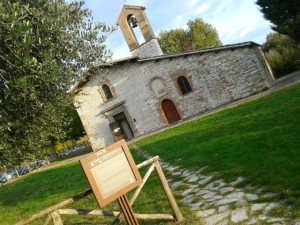
Here he founded the first home for the 12 Friars Minor & nearby he tamed the Wolf of Gubbio who had been eating livestock and human beings, terrorising the town. Inside it is wonderfully peaceful … Chiesa dalla Vittorina.
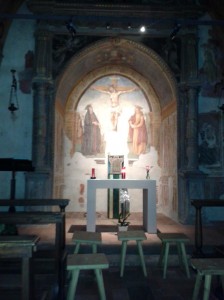
Quick shop in the La Mura complex where ITim try to connect up my Virgin mobile phone but fail and purchase some organic milk and biscuits in the adjoining Co-op. On to the Roman semi-amphitheatre at dusk – the mausoleum commemorating the 40 martyrs is closed, so it’s back to the Bosone Palace.
Supper this evening is in the sister establishment to the Bosone Garden – same price menu del giorgno but, even though it has a higher reputation Michelin * etc. it is not so good : La Taverna del Lupo – I have parma ham & melon, gnocchi with parmesan, a few slices of roast pork + rosemary potatoes. The best course is pudding … a pile of whipped cream with caramel and chocolate flakes. Wonderful vaulted rooms where the Via Anseidi crosses the Via della Republica.
Thursday 30th October 2014
Last bit of sightseeing in Gubbio, two churches, one undergoing restoration the second closed, then it’s off to retrieve the Fiat 500 from its underground resting place. I am Spello-bound, once again through delightful countryside on quietish roads. Just a brief word about Italian drivers – there are quite a few annoying habits, the worst being tail-gating inches from one’s back bumper … white van men being the worst culprits. Very little indication, aggression the norm.
Park free at the bottom of Spello. Wander up the steep main street and round the city walls to the right. Pretty, as are all these hill towns but once again I am relieved I did not choose to stay. There is not much action amongst the place’s 8,000 inhabitants. Caffe latte by the main Roman gate.
Read up about my next stop, Perugia, and where to park … head for the Piazza dei Partigiani. Big underground car park and then a succession of escalators takes one up to the elegant Piazza Italia where the broad pedestrianised Corso heads up to their Duomo. Busy busy studenty city.
Absolute highlight here is the Galleria Nazionale dell’Umbria (about €8 entry) on the left hand side. A treat, even for a bit of an alleged Philistine like myself. Beautifully lit and described, there are works by Vanni, Vanucci, Nelli, Piero della Francesca (take photo), Buoninsegna, Pisano, Pinturicchio – a Bernini gold tree of leaves leaves a lasting impression. There is also a temporary Canaletto exhibition with 4 or 5 of his masterpieces. Walk around the upper part of town – a panoply of fine medieval architecture. Back through the arched brick vaulting on the down escalators and out of town on fairly busy roads towards Siena.
Skirt round the Roman walls going left round the hills and valleys past the Porta Romana, the Porta Tufi to my destination the Porta San Marco … just below the hotel I have chosen from 2 guidebook recommendations – The Palazzo Rivazza. Park car by the city gate while I investigate room availability (yes, single is €80 b&b), luggage drop & how to get to their private car park.
My hotels on this trip, Assisi, Gubbio, Siena have been ‘good, better, best a my friend Vole describes my Israel diaries (’92,’95 and 2012) ! The Palazzo Rivazza is fabulous value, my room on the 4th floor has a side-view of the Cathedral and tower – a sumptuous pillowed bed, blue and white tiled bathroom, wifi on tap. Italianate gardens on terraces down towards their car park & a bench where Aldous Huxley is pictured sitting. Helpful staff.
I drop my washing at a local Lavanderia – €15 for 4 pairs socks & knickers, 4 T-shirts, 2 shirts & 2 trousers – expertly done and hand-delivered back to my hotel the following day.
Little bit of evening exploration in the local area … street patterns are somewhat confusing at first. On the Via di Stalloreggi close to the Pian dei Mantellini junction is a calligraphist and artist at work in his shop – sadly he was always shut when I returned to make a purchase. Supper is at a great and popular, even in this quiet section of Siena, little pizzeria by the Carmine church @ Villa della Diana. Choose one with onions, salami, bufala mozzarella & tomatoes followed by an indifferent tiramisu. The place is run by the partner of the Lavanderia lady – they are agreeable and friendly hosts.
Friday 31st October 2014
Siena wakes up slowly – it’s 10a.m. before anything really gets going. Good breakfast of decent coffee, fresh breads, cut your own salami & cheese; comfortable Lloyd loom chairs and glass-topped tables. My street savviness improves as I descend towards Il Campo – Siena’s scalloped central circus – home of the Palio horse race contested by is it the 17 ? local Contrades (effectively gangs from each neighbourhood) with names like Porcupine, Dragon, Eagle, Goose and Panther. The Palio takes place on July 2nd and August 16th each year.
First port of call is the splendid Basilica di San Francesco set behind a large open Piazza, home to St.Bernardino and the Eucharistic Miracle of Siena. Then to possibly the world’s most beautiful bank head-quarters in the Piazza Salimbeni named after the 15th century founders of the Monte dei Paschi di Siena. There is a rival for that accolade, some private bank operates from rather a gorgeous building above and to the west of the Campo.
Anyway, I am given a private viewing of the bank’s archives and told of its important history helping to rescuscitate Siena with its lending and charitable acts after the Black Death. Fascinating ledgers and manuscripts housed in quite a fine modern framework & the loos were spotlessly clean.
Also devoting herself to the poor and sick in post Black Death Siena was Caterina Bencassa, born in 1347 – experiencing visions from the age of 5 and painted by her friend Vanni in 1414 during one of her ecstasies. At the Casa e Sanctuario di Santa Caterina (her family home) I am brusquely admonished for taking a picture in the downstairs chapel of one of the ‘mostly unexceptional Baroque canvasses’ adorning the side walls. Not a nice curator … “Fuck, fuck”, were his eloquent parting words. Honestly, everyone everywhere ignores the ‘no photo’ signs. 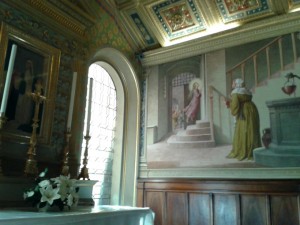
Next on the itinerary is the €12 Opa SI Pass to the sites around the zebra-striped Duomo. It’s first into the Museo dell’Opera har by the ticket office – full of Madonna & Child pictures by amongst others Duccio, Martini, Lorenzetti and della Francesca. Up to the scary Panorama del Facciatone – heights are not my thing.
Tour the Battistero and the Cripta before entering the main church with its famous floor and Pisano’s massive detailed pulpit – any preacher ascending there must feel important. In the side chapel, the Libreria Piccolomini are Pinturicchio’s frescoes … attempt a panorama photo of one wall.
Back to my lovely hotel on the Pian de Mantellini for a rest before venturing out again for some more sightseeing. Am recommended Santa Maria dei Servi for its views of Siena which do not disappoint. Forgot to mention that after the Duomo I crossed the Piazza, paid  another €8 and entered the voluminous vaults of the extraordinary Santa Maria della Scala. Originally, from about 1250, it served as a hospital for travellers and pilgrims – now it houses a mix of modern art, chapels, the archaeological museum & historical sections. It’s all a bit dark and spooky as you descend in twists and turns through poorly lit corridors passing Roman funerary urns and sarcophagi. Quite a relief to reach the open air again.
another €8 and entered the voluminous vaults of the extraordinary Santa Maria della Scala. Originally, from about 1250, it served as a hospital for travellers and pilgrims – now it houses a mix of modern art, chapels, the archaeological museum & historical sections. It’s all a bit dark and spooky as you descend in twists and turns through poorly lit corridors passing Roman funerary urns and sarcophagi. Quite a relief to reach the open air again.
Up from the Porta Romana area, brief look into the Chiesa Santo Spirito and contemplate a purchase in a jewellery shop … it’s a nice design (as if a man can discern such) of silver banding with sparkly bits encased in a Greek key-style setting. The ring isn’t cheap … would this help to cement a frayed relationship ? It turns out that the glistery stones are not diamonds which would raise the price ten-fold. Anticipating : “Zircons; I spit on them !”, I decide against. Instead I am stocking up on Siena’s panfortes in different sizes and flavours – this used to be food for weary pilgrims & makes nice gifts.
Another €8 expended for entry into The Museo Civico underneath the soaring Torre del Mangia (I won’t be climbing up there) – it is money well spent here in the city’s Palazzo Publico. The two lower floors are given over to an uninspiring modern exhibition of ‘mechanical fishes’ … all very samey. But upstairs are rooms from all centuries, yet more Madonna & Childs (slight fatigue setting in with these !) until one reaches the Sala del Mappamundo. Lorenzetti’s circular map now faded but Simone Martini’s Maestă is here and the terrific Equestrian Portrait of Guidoriccio da Fagliano probably by Martini but art historians are still bickering over its attribution & so it may be by Duccio, Lorenzetti or even Filippucio (who he ?, Ed.). Then in the next room, equally astonishing, are Lorenzetti’s famous allegories of Good and Bad Government – wonderful stuff. Elsewhere in the building among the ‘treasures’ is another lovely gold tree and leaves done by Bernini.
Central Siena is built on a Y-shaped convocation of ridges and the afternoon tour continues up the ridge to the north-west – Via Bianchi di Sopra contains smart but expensive shops but leads via the Piazza G.Matteotti (home to the main post office) to the dominating presence of San Domenico where a service is just ending. Built from 1226, it was here that St. Catherine received the stigmata and performed several of her miracles. Rather gruesomely her head is preserved behind glass in a side chapel. She died in Rome in 1380, only 33 years old – was it in ghastly circumstances ? Recently she has been made co-Patron Saint of Italy with Francis di Bernardone.
Her Basilica has rather a nice shop where I spend time browsing and buying a few postcards. More shopping opportunities arise on the Via della Sapienza. My Gucci lookalikes, cobbled together over the past few years, are getting a little tired and old (like their owner). There is a smart pair of elegant black shoes, albeit sans buckle, going for €79 but I just baulk at the price and do not purchase. But Italians make wonderful shoes, eh ?
Saunter back to my hotel, passing the still closed painting & calligraphy shop – wash and brush up and, tempting though it is to return to the nearby pizzeria, instead I head (on receptionist’s suggestion) to the Cice Restaurant on the Via San Pietro. Busy, partly with fellow hotel guests; an excellent mozzarella & tomato salad + basil & do-it-yourself olive oil/balsamic vinegar/salt & pepper. Secondi platti of pork with apples and prunes is but fair – washed down with a bottle of still water. The restaurant is close to the Pinacoteca Nazionale, just about the only major site I have not visited in Siena … but perhaps it’s chock-a-block with Madonna & Childs ?!
Saturday 1st November 2014
I have arranged by email to arrive at Dave & Sascha’s near Ortobello at lunchtime. Early start allows some diary writing before breakfast and departure south-westwards – I have spotted in the guidebooks a couple of suitable staging posts to visit en route. Nice windy road through Rosia to the ruined L’Abbazia di San Galgano and its special church on the hill, L’Eremo di Montesiepi where the warrior who found God plunged his sword into rock in the 1170s and where it remains embedded.
Onwards to the town of Massa Marittima passing men in day-glo parkas parked up for a spot of hunting – pity the poor birds of Italy these days not to mention the sangliers/wild boars. ‘Owt that moves above the grass is fair game here. Quick tour of this hill-top town with its steep streets – up past Chiesa San Francesco to the Sant’Agostino church & cloisters then down the Via Moncini to the beautiful medieval splendour of the Duomo and Piazza Garibaldi in the lower Cittă Vecchia. Dedicated to San Cerbone, Patron Saint of Massa.
To the coast and left on the dual-carriageway to the Albinia/Argentario exit and arrive at the Hart’s house at about 1.30p.m.. My large box of PG Tips is appreciated – Annabel and Odile, their eldest and youngest daughters usher me and the motor through the narrow gates. The gas has been cut off because Dave hasn’t paid the bill so there is no hot water but what hey, there is an open fire on which we can boil saucepans of the over-chlorinated water.
Lovely al fresco lunch before a walk up and down the nearby beach (which disappeared for several years due to rising sea levels but is now returning) to an ice-cream café. Lots of sword-fighting with the girls with bamboo and other sticks washed up. Night falls sharpish at 5p.m. but at least we have electricity.
We are joined by an old school-friend of ‘Annie’s’ on a sleepover & all pile into the extra long Mercedes estate that they have recently bought for £2,500 – similar year and dashboard display as my own vehicle back home.
There is a local produce festival going on in Orbetello – wine tasting (the best was a sweet white made from the usually average Vermentino grape from the Tenute Perini vineyard – but it’s €28 for a small thin bottle) and then a chaotic queuing system for a good supper in a large tent. Plates of meat or cheese or the local vegetable soup.
We notice a rabble of out-of-control children ‘playing’ at one side of the tent. They overturn benches noisily and eventually parents appear to collect them – but they have no ‘boundaries’, no rules these Italian children & can do no wrong in their parents’ eyes. I suspect this transmutes into their adult behaviour, their arrogant driving techniques and their inability/lack of desire to pay income tax. Muse upon that, my attempt at amateur social psychology.
Excellent sleep in the all white room – the copious slugs of white wine may have helped.
Sunday 2nd November 2014
Bit of boy scout work gets the fire going in the morning – matches, cardboard and fir-cones (as we are surrounded by umbrella pine forest here). Attempt to influence Dave’s musical appreciation as he’s stuck in Little Feat & similar mode. Introduce him to Arcade Fire, Elbow and Editors – he says he knows Enya (mind you, she’s been a bit quiet of late). We compose a joint postcard to Hutchy, my step-sister who, with her husband David, has a house nearby and a flat in Rome.
I drive Dave in to Porto San Stefano where we enjoy gin & tonics 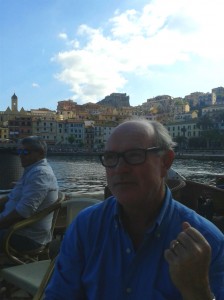 at the Café Julia on the front. Then back for a barbecued beef lunch with roasted potatoes and courgettes. Eschew any further alcohol before heading northwards at about 3p.m. aiming for Lucca in daylight. The Via Aurelia road surface is poor until fairly close to Pisa where it meets the motorway. It’s dark when I reach the outskirts of Lucca – park a shortish distance outside the city walls, sort out a smaller overnight bag and head through the Santa Anna/Porta Victor Emanuele gate and up his road to the centre of town. Find my chosen hotel fairly easily, the Piccolo Hotel Puccini in Via di Poggia just 100 yards from the superb front of the Chiesa San Michele. A little scruffy, the hotel not the church, but more than adequate for one night at £60 right in the middle of Lucca.
at the Café Julia on the front. Then back for a barbecued beef lunch with roasted potatoes and courgettes. Eschew any further alcohol before heading northwards at about 3p.m. aiming for Lucca in daylight. The Via Aurelia road surface is poor until fairly close to Pisa where it meets the motorway. It’s dark when I reach the outskirts of Lucca – park a shortish distance outside the city walls, sort out a smaller overnight bag and head through the Santa Anna/Porta Victor Emanuele gate and up his road to the centre of town. Find my chosen hotel fairly easily, the Piccolo Hotel Puccini in Via di Poggia just 100 yards from the superb front of the Chiesa San Michele. A little scruffy, the hotel not the church, but more than adequate for one night at £60 right in the middle of Lucca.
Out for a wander in the streets swarming with the remnants of their weekend’s Goth Festival – there’s all sorts here, Italian youth dressed ghoulishly, marquees devoted to the dark arts, odd cartoon characters, Star Wars tents, bizarre Comedia dell’Arte stuff and the streets are litter-strewn. I walk for miles, some on the city walls, down to the Porta Elisa after viewing the Duomo and back towards the centre past the Chiesa San Francesco. Lucca’s street pattern is even more confusing than Siena’s and it is hard to relocate the Piazza San Michele – I suppose the two main arteries are the Via Fillungo and the Via del Fossa which follows the Roman ‘fossa’ or ditch, probably still acting as a city sewer. Catching my eye were the Chiesa Santa Maria Forisportam, a frescoed arch nearby on the Via Santa Croce and nearer San Michele, the zebra-style facade of the Chiesa di San Cristoforo.
Eventually sit down for supper on the terrace of Ale’s Bar at Piazza XX Septembre – generous portion of insalata mista, then an excellent plate of hot fusilli with pesto + a glass of white … €20.
Monday 3rd November 2014
Need to be at Pisa Airport 9ish so do an early walk down the Via Fillungo to the Piazza Antifeatro which features on most Luccan postcards. The dustbin-men have done an excellent job throughout the night and Lucca is pretty much back to her prettiest. Precious little activity at 7a.m. but the Piazza, built in medieval times over the old Roman arena is worth seeing as is the third of Lucca’s trio of outstanding churches, the Chiesa San Frediano.
Back for a rather poor breakfast ‘tray’, pay the bill and walk back to 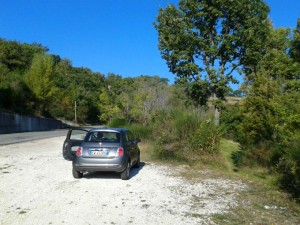 the car. Fill up with petrol very close to the airport & return the little grey Fiat 500 with 1,141 extra kilometres on its clock. This is achieved with minimum fuss but still without a vehicle check. Then walk over to the terminal. Even though it’s a small airport it’s all a bit haphazard and chaotic but soon enough, I guess, I am all checked in and busy duty-free shopping. A bottle of Mexican tequila for Stuart, my blogsite guru … a few packs of cigarettes for my daughters – a long wait on the tarmac for no obvious reason.
the car. Fill up with petrol very close to the airport & return the little grey Fiat 500 with 1,141 extra kilometres on its clock. This is achieved with minimum fuss but still without a vehicle check. Then walk over to the terminal. Even though it’s a small airport it’s all a bit haphazard and chaotic but soon enough, I guess, I am all checked in and busy duty-free shopping. A bottle of Mexican tequila for Stuart, my blogsite guru … a few packs of cigarettes for my daughters – a long wait on the tarmac for no obvious reason.
Back at Gatwick by lunchtime (in pouring rain) and home within an hour or so. Snappy Snaps is conveniently located at Clapham Junction who efficiently process my phone photos onto ‘hard copy’.
Ciao, grazie, Italia.




